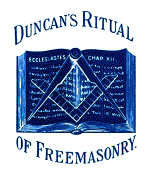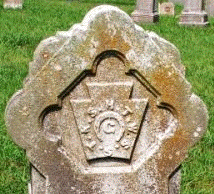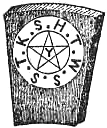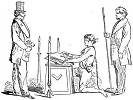 |
read the entire Mark Master, or Fourth Degree ceremony at
Malcolm C. Duncan's 1866
Duncan's Masonic Ritual and Monitor of Freemasonry
The candidate is then furnished with a block representing a keystone, which he is requested to carry between the thumb and two first fingers of the right hand, the other fingers clinched with the nails tight against the palm, the arm extended down perpendicularly at the side. The two officers carry their blocks in the same manner. The three are styled "Workmen from the quarries." As we have before said, the block which the candidate carries represents a keystone, and has the initials H. T. W. S. S. T. K. S. engraved upon it in a circle.
...
Candidate presents the keystone. |
| Junior Overseer (applying his square to it, and finding it does not fit.) | This is a curiously wrought stone, indeed; it is neither oblong nor square; good work, true work, square work is only such as we have orders to receive; neither has it the mark of any of the craft upon it. Is that your mark? (Pointing to the letters on the keystone.) |  |
| Candidate | It is not. |
| Junior Overseer | Owing to its singular form and beauty, I feel unwilling to reject it; you will pass on to the Senior Overseer at the west gate for his inspection.
The conductors and the candidate pass on to the Senior Overseer's station in the west, when the same scene is repeated, and they are directed to proceed to the Master Overseer at the east gate.
The Senior Deacon here first presents his block or stone to the Master Overseer. |
| Master Overseer (applying his square.) | This is good work, true work, and square work -- just such work as I am authorized to receive and pass for the building. You are entitled to your wages -- pass on.
The conductors pass on, and take their seats. The candidate then presents his keystone. |
| Master Overseer (applying his square.) | This is a curiously wrought stone. It appears to be neither oblong nor square, and the mark upon it is not that of a craftsman. (Looking sternly at candidate.) Is this your work? |
| Candidate | It is not. |
| Master Overseer | Where did you get it? |
| Candidate | I picked it up in the quarry. |
| Master Overseer | Why do you bring another man's work to impose upon the Overseers? You will stand aside.
The Master Overseer now stamps on the floor four times with his foot, which brings up the other two Overseers. |
| Master Overseer | Brother Junior Overseer, dial you suffer this work to pass your inspection? |
| Junior Overseer | I did; I observed to the young craftsman, at the time, that the stone was not such as we had orders to receive; but, owing to its singular form and beauty, I felt unwilling to reject it, and suffered it to pass to the Senior Overseer at the west gate. |
| Senior Overseer | I made the same observations to the young craftsman, and for the same reason permitted it to pass to the Master Overseer at the east gate. |
| R. W. M. | Why, you see the stone is neither oblong nor square, neither has it the mark of any of the craft upon it. Do you know this mark that is upon it? |
| Junior Overseer | I do not. |
| Senior Overseer | Neither do I. |
| Master Overseer | What shall I do with it? |
| Junior Overseer | I propose we heave it over among the rubbish. |
| Master Overseer | Agreed.
The Master and Senior Overseers take up the keystone, and swinging it four times back and forth between them, the fourth time the Junior Overseer catches it over the left shoulder of the Master Overseer (in imitation of the sign of "heave-over," see Fig. 19), and throws it aside.
The Right Worshipful Master, after admonishing the candidate never to give the words in any way but that in which he received them, resumes his seat, when the brethren shuffle about their feet. |
| R. W. M | What means this disturbance among the workmen, Brother Senior? |
| S. G. W. (rising.) | Right Worshipful, the workmen are at a stand for the want of a certain keystone to one of the principal arches, which no one has had orders to make. |
| R. W. M. | A keystone to one of the principal arches? I gave our Grand Master, Hiram Abiff, strict orders to make that keystone, previous to his assassination. (Gives two raps with his gavel, which brings the three Overseers before him.) Brother Overseers, has there been a stone of this description brought up for inspection? (Exhibiting the figure of a keystone.) |
| Master Overseers | There was a stone of that description brought up for inspection, but it being neither oblong nor square, nor having the mark of any of the craft upon it, and we not knowing the mark that was upon it, supposed it unfit for the building, and it was thrown over among the rubbish. |
| R. W. M. | Let immediate search be made for it; the Temple cannot be finished without it; it is one of the most valuable stones in the whole building. (The brethren then shuffle about the Lodge again, and find the keystone, and bring it up to the east.)
The Senior Warden takes the stone from the hands of the brethren, and then reports to the Right Worshipful Master as follows: | |
| | Right Worshipful Master, the stone has been found; it was discovered buried in the rubbish of the Temple, and I herewith transmit it to you, by trusty brothers. (Two or three of the brethren carry it to the Right Worshipful Master in the east.
The Right Worshipful Master receives the keystone and places it in front of him, on the desk, upright and plumb, with the initials on it facing the whole Lodge, but more especially the candidate, who is seated in a chair in front of the Right Worshipful Master. 1
The Right Worshipful Master gives four raps with the gavel (• • • •), when all rise to their feet. (Some Lodges do not do so, but keep their seats.) When he reads the following passages of Scripture, at the end of each passage he strikes the keystone on the top with his gavel -- first, one rap; second, two raps; and so on to the fourth passage, viz.: |
| Right Worshipful Master strikes the keystone once. (•) | "The stone which the builders refused is become the head stone of the corner."
Ps. cxviii. 22. |
| Right Worshipful Master strikes the keystone twice. (• •) | Did ye never read in the Scriptures, "The stone which the builders rejected is become the head of the corner"?
Matt. xxi. 42. |
| Right Worshipful Master strikes the keystone thrice. (• • •) | And have you not read this Scripture, "The stone which the builders rejected is become the head of the corner"?
Mark xii. 10. |
| Right Worshipful Master strikes the keystone four times. (• • • •) | What is this, then, that is written, "The stone which the builders rejected is become the head of the corner"?
Luke xx. 17. |
| Master reads to candidate from text-book: | "To him that overcometh will I give to eat of the hidden manna, and I will give him a white stone, and in the stone a new name written, which no man knoweth, saving him that receiveth it." (Rev. xi. 17.) Come forward, and receive the new name.
Candidate steps forward. |
| Master | Brother, I will now invest you with the new name that none but a Mark Master can receive. It is a circle of letters which are the general mark of this Degree.
Here the Right Worshipful Master calls the candidate's attention to the keystone before him, by pointing out to him the initials on the stone, which he is informed read as follows:

HIRAM, TYRIAN, WIDOW'S SON, SENDETH TO KING SOLOMON.
The candidate is here instructed how to read the words when challenged by any stranger, which is as follows:--
HIRAM, TYRIAN, WIDOW'S SON, SENDETH TO KING SOLOMON.
The candidate is here instructed how to read the words when challenged by any stranger, which is as follows: | |
| R. W. M. | Hiram. |
| Candidate | Tyrian. |
| R. W. M. | Widow's. |
| Candidate | Son. |
| R. W. M. | Sendeth. |
| Candidate | To. |
| R. W. M. | King. |
| Candidate | Solomon. |
| R. W. M. (pointing to the centre within the circle of these letters.) | Within this circle of letters every Mark Master Mason must place his own private mark, which may be any device he may choose to select; and when you have selected your mark, and it is once regularly recorded in the Book of Marks of this or any other Lodge of which you may be chosen a member, you have no more right to change it than you have to change your own name.
Marks are not generally recorded; this duty is very much neglected -- it should be done, and strictly enforced in every Lodge. |
| Master reads to candidate: | "He that hath an ear to hear, let him hear."
Rev. iii. 13. |
| The Master further instructs the candidate in the signs of the penalties of this Degree (see Figs. 19, 20, 21, and 22), and then presents, or points out to him on the chart, the working-tools of a Mark Master Mason, viz.: a mallet and chisel, the use of which he explains as follows:
The chisel morally demonstrates the advantages of discipline and education. The mind, like the diamond in its original state, ... |





